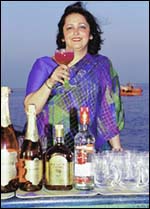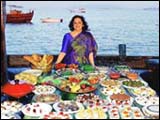


 Food Ahoy
Food AhoyFarzana Contractor catches a cruise and super evening aboard SWATI PIRAMAL'S 'Haveli of the Sea Horse' |
|
SWATI PIRAMAL'S living room has shifted. From Piramal House in swanky, upmarket Worli Seaface, to the hold and deck of an old Arab dhow gently riding the waves on the Arabian Sea a few nautical miles outside the city. The Piramals no longer hold their cheese and wine nights and champagne breakfasts at home. Nor in the ballrooms and suites of five star hotels like they earlier used to. Instead, they ferry their guests by speedboat to the dhow and hold a cruise and supper evening there on the high seas. Travellers of the world swear that luxury cruise liners have nothing like it. You may keep your memories of the Titanic, an invitation to the Piramal's vessel is really to die for.
The catering for the Piramal's cruise and supper evenings is taken care of by Swati's Cordon Bleu chef mother, Arunika Shah. She runs a catering service called Celebrate (362 4133, 367 9817) with speciality confectioner Devina Shah. The menu is always gourmet food. She uses the Arab dhow as a theatre for her style of cooking. Her food is light, and it is always stir-fried or steamed, cooked very naturally in virtually no oil. There are plenty of salads, fruits and a dozen or so desserts. Plus fondue and dips. And a bar equipped with an amazing collection of wines, champagnes, spirits and liquers. It is skillfully managed by a barman gifted in the art of mixing exotic cocktails. The waiters are all old sailors with steady hands and dexterous feet. You may count on them not to spill your Martini as they roll along the deck when the dhow has got her sails up and is taking in the breeze.
The Piramals's cruise and supper evenings are the in thing in Bombay's night life. They are held at least thrice a week, which should give you an indication to the kind of entertaining Swati and Ajai Piramal do. All kinds of people, from powerful captains of industry to consuls, from socialites to film stars and from media tycoons to medical bigwigs, hope to get invited to one of these evenings. The lucky few who do, have a genuine love for the sea. "The Godrejs are regulars," says Swati Piramal. "Nadir and Jamshyd, they are sailors, and there are plenty of retired admirals who love the sea and who we have aboard, then there are the Ambanis, Birlas, Mariwalas, the Bajajs had a wedding party here, other friends celebrate their anniversaries, and there's Gunter Kreuger of the Indo-German Chamber of Commerce who is quite a sailor himself. Barry Clarke of Boots and Vernon Sankey also come often."
The Arab dhow is called the Haveli of the Sea Horse. She is an 118-year-old wooden boat that used to carry coconuts and timber from the Lakshadweep Islands across the Arabian Sea to Dubai. The dhow is completely made of wood. There is no fibre glass and steel. And she is made the old-fashioned way, handstitched with cotton thread and bound by fish oil. The timber is joined together by a process known as caulking. Five thousand years ago, this is how the Portuguese traders used to build and stitch their boats, and Vasco da Gama is supposed to have found India by navigating the seas on an old Arab dhow like this one.
This particular vessel has a past that could well be a slice of the country's maritime history. In what was once the hold that used to store coconuts, the Piramals have created a multimedia room in which they show their guests a short, 15-minute audio-visual on the Haveli of the Sea Horse. The fishing family that owned her for generations, used to sail her according to the monsoon winds. She has sailed to China in the East, to Zanzibar and Africa in the West and Persia in the Middle East. It is said that some of the Indian cottons and fine muslins from Gujarat that used to adorn the magnificently sculpted form of Cleopatra, were carried across the Arabian Sea by the Haveli of the Sea Horse.
The Piramals bought her from the Lakshadweep fisherman's family because the current generation there did not want to continue the family business. "We got her in a very bad state and we bought her for practically a song," says Swati Piramal. "When I heard that she was for sale, I travelled to see her at the Lakshadweep islands. She was anchored in an area that was predominantly Muslim and I had to cover myself with a chaddar when I went to meet her owners. I fell in love with her at first sight."
The dhow was restored to her state of present glory and sea-worthiness by an old salt called Captain Soli Contractor from a small dock along the Mangalore coast. He fitted her with two engines, repaired and covered her leaky old bottom with copper and handed her over to the Piramals ready for the sea again. The architect Suresh Sethi then took over. He decided not to change the dhow's interiors and kept his designs as natural and original as possible. Then, Swati Piramal added the final artistic touches. She painted the dhow in blues and emeralds, the colours of healing, using the same hues and tones that her havelis in the Rajasthan desert wear, gave it old-fashioned brass lighting fixtures and installed furniture that was handpainted. She gave the dhow the name Sea Horse because, Swati Piramal had studied in marine biology, the dhow was like the sea horse, an endangered species on the Konkan coast.
Today the Haveli of the Sea Horse proudly bobs in the waters off the Gateway of India alongside glittering luxury cruisers, oil tankers, merchant navy cargo ships and destroyers, submarines and aircraft carriers of the Indian Navy. She is two-storeys tall, 40 feet wide and 80 feet long, and with her sails unfurled as she majestically rides the waves to Dharmantar Rock in the twilight hour, she is something to look at.
Swati Piramal insists that the best time to be on board is at dawn, at the start of a fresh new day. "At that time, the small fishing boats with their lanterns blazing are scurrying about the dark waters like glow worms," she says. "It is a part of Bombay I have not experienced before. Ah, the fading moonlight on the water, the gentle heave of the waves, the tang of the salt breezes. All this, and I am just 25 minutes away from home."
|

Home Page
About the mag
Subscribe
Advertise
Contact Us

